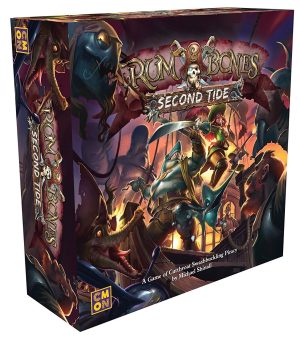
Rum and Bones: Second Tide is a board game that combines pirates with ideas drawn from Multiplayer Online Battle Arenas (MOBAs). The concept alone is worth a million doubloons; but how well does it work in practice?

If you’re not familiar with a MOBA, it’s basically an online multiplayer arena brawl where two teams of players square off. Each controls a single character attempting to push up through “lanes” and slay AI-controlled minions as well as opposing heroes. It’s an addictive esport due to the intense level of competition accompanying RPG-like character growth. This winning formula has propelled games like League of Legends to the top of the charts.
But translating that experience to the tabletop world—capturing that dynamic flow while minimizing a mountain of overhead—is tricky. Rum and Bones already took its shot with the original 2015 release. The second edition, released last year, streamlines the existing ruleset to narrow its vision and strike closer to its MOBA DNA.
Much like the first go-round of Rum and Bones, the results are a mixed bag.
A pirate’s life
You’re a pirate, and the goal here is to be the first player to amass eight victory points. This is accomplished by destroying enemy objectives—rigging, sails, etc.—or by plunging your rusty blades into the squishy flesh of opposing heroes, knocking them out of action. The latter path is a new addition in Second Tide and helps to rein in the length of play. One large issue with the original release was the penchant for players to ignore targets and the whole affair to last an unreasonable amount of time.
The issue with this change is that playtime is still somewhat bloated, undermining the patch job. More importantly, games will often finish with few objectives demolished. It’s exceedingly easy to get caught up in the back-and-forth struggle of miniature-on-miniature violence and commit to the kill. The tragedy here is that the game steers away from its MOBA ancestry, yet those are the exact pieces that differentiate this release from the scores of tactical miniatures games.
Battling it out with your trio of heroes is solid fun, though. One of the factions includes half-man, half-fish marauders who inspire wide grins. Grabbing hold of the rigging and leaping from one ship to the other like Manimal gone feral offers a galley full of thrills. Cutting down the weak deckhands and utilizing a suite of asymmetrical special powers is satisfying and does capture the qualities of its influences. You spend coins earned from slaughtering foes to purchase and upgrade your abilities, increasing player investment and joy. The entire hero aspect of the game is spot on and fulfilling.
But apart from the heroes, the other half of your force is the mindless crew. This collection of pale-faced swashbucklers moves toward the opposing ship with all the cunning of a hungry zombie. They follow a set path, stopping when they run into the enemy and throwing down a meager attack. Conceptually, this is fine as it mimics the pressing creep found in MOBA designs; it gives you shiny targets to blow apart with your sluggers. Unfortunately, tedium creeps in as the repetitive nature of moving an army of faceless miniatures turn after turn overwhelms. The back-and-forth dynamic of crew slamming upon crew feels incremental and boring, a stark shift from the gripping nature of hero play. It saps much of the momentum by saddling players with all the overhead of constant figure movement, thus highlighting a limitation of cardboard gaming.
-
Charlie Theel
-
Charlie Theel
-
Charlie Theel
-
Charlie Theel
-
Charlie Theel
-
Charlie Theel
Counter-balancing that tedium is the slick activation system that throttles back and forth between players. Each player takes a turn activating a single hero or an entire crew before pitching play back to their opponent. This offers a much-improved feel to the first iteration of this design, which had players activating all of their pieces within a lengthy turn structure. You can respond more tactically within the boundaries of this system and downtime is reduced.
This system also helps to approximate some of the speed of a real-time game. The board develops in interesting ways and priorities shift more quickly. It helps to keep you cognitively engaged, at least when you’re not scooping up those crew members by the handful and slowly nudging them toward doom.
Release the Kraken!
Bolstering the solid atmosphere are the numerous little flourishes, like the fact that each side has a deck gun that gets to rain down pain each round. One of my favorite aspects is the ability to leap from ship to ship via suspended rigging. (Players can also draw the attention of the neutral Kraken as the cost of playing powerful cards from their hand each round. Eventually, this sea beast rises from the depths and terrorizes everyone nearby; it’s dramatic, engaging stuff.)
All of this drama is bolstered by the dice-based combat, where you toss handfuls of six-siders looking for hits. Many elements of this game let loose and commit to randomness head-on. Those attracted to the lovely miniatures and over-the-top theme will have no problem buying into some chance cube chaos.
Rum and Bones: Second Tide is a tough one. It has moments of glory scattered among rote actions and monotony. Its playtime can occasionally extend too far, and it primarily functions as a two-player game. (Rule options exist for three or four participants, but this feels forced into the play-space and is accomplished by slicing the creative control of each team in half.)
If you can push the problems below deck and out of sight, you can ride headlong into the storm with a pistol in each fist. If you can’t, well, there’s always League of Legends.
reader comments
9